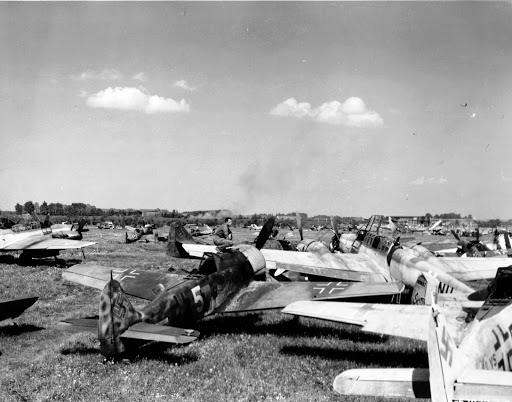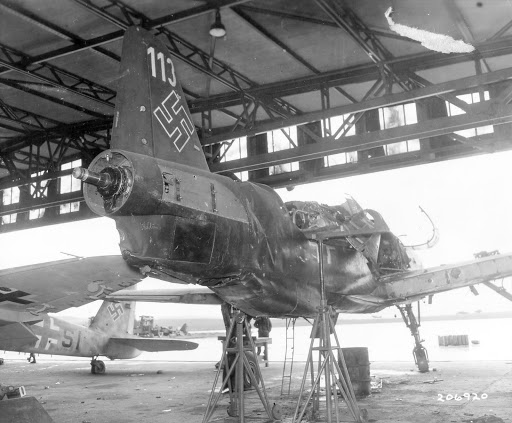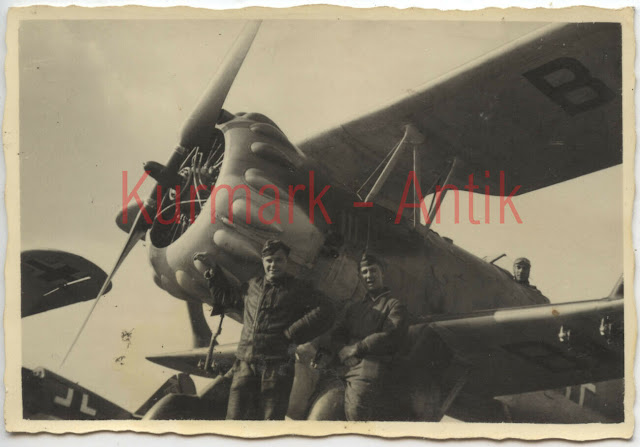Up-dated with more items available on "buy-it-now", UK sales only please due postage costs. There are some heavy books here..!
http://www.ebay.co.uk/sch/sturmgruppe/m.html?item=230725088455&viewitem=&_trksid=p4340.l2562
Saturday, 31 December 2011
Thursday, 29 December 2011
rare Hans Ulrich Rudel Fw 190 photo sequence - Schlachtflieger Ju 87 G BK 37
While searching for 'Schlachtflieger' on ebay.de, I came across the following two images, claimed to be originals, depicting Hans Ulrich Rudel at the controls of a Fw 190. The first shot below was new to me, the second has been seen widely on the net although this one seems to be a decent reprint. For anyone not aware of other images in this 'sequence' it is not immediately obvious that the pilot seen taxiing out in 'chevron bar' with its yellow Rumpfband is in fact Rudel himself.
A look at a couple of the other images from the same series allows a positive ID. The 'sequence' is from the ECPA-D archive in Paris and was apparently photographed in Rumania during the summer of 1944. Rudel as Kommodore of SG 2 is shown getting ready for a sortie.
I have a couple of prints from the sequence including another view of Rudel strapping into his chute (above). AFAIK only one other image from the same sequence has been published, most notably in Chris Ehrengardt's 'pilotes de Stuka' article ( which appeared in CJE's own Aerojournal, issue 4) . Note the mechanic on the wing (left, below) is the same figure lying on the wing in the first photo above.
Rudel's preferred mount was of course the Ju 87 Kanonenvogel fitted with the BK 37. Nice image from a war-time Hungarian publication.
Quoted in Tony Williams, 'Flying Guns – World War 2';
"..The BK 3.7 was not a particularly impressive gun. It was a modified version of the FlaK 18 AA gun, was big, heavy and slow-firing (in comparison with the NS-37) and the ammunition clip could only contain a maximum of twelve rounds (six and eight-round clips also being used). However, it was quite powerful and the tungsten-cored Hartkern munition could be extremely effective, penetrating 140 mm / 100 m / 90°, although this reduced sharply to 70 mm at 60°..."
Indeed the Kanonenvogel bore witness to the appalling penury and deficiencies of Luftwaffe resources on the Eastern Front. Here was a machine conceived for taking out tanks individually - one by one if you will. The central weapon of war on the Eastern Front was the tank - the Soviets had lost the armoured battles of 1941 with 11-ton T-26 and 14-ton BT light tanks. These were replaced en masse with a new generation of heavy tanks during 1942 and 1943. Both the T-34 and 45-ton KV heavy tanks toted 76mm guns - even two years later 76mm was the biggest American and British tank gun. Soviet factories started churning out thousands of them monthly - well out of the range of any Luftwaffe bombers - 15,700 T-34s in 1943 alone (quoted in Evan Mawdsley, 'Thunder in the East'). By the time the Germans could field a tank to match the T-34 the Soviets had a huge numerical , if not qualitative, advantage. The up-gunned T-34-85 featured an 85mm gun and over 18,000 of these were produced during 1945. At the time of course Rudel's efforts and those of his comrades were feted in the Nazi propaganda media. Today they are still 'celebrated' in just about every account you might care to read devoted to combat flying on the Eastern Front. In reality Rudel's 'achievements' were but a drop in the ocean, a mere pinprick in the overall scheme of battle on the Eastern Front..
A look at a couple of the other images from the same series allows a positive ID. The 'sequence' is from the ECPA-D archive in Paris and was apparently photographed in Rumania during the summer of 1944. Rudel as Kommodore of SG 2 is shown getting ready for a sortie.
I have a couple of prints from the sequence including another view of Rudel strapping into his chute (above). AFAIK only one other image from the same sequence has been published, most notably in Chris Ehrengardt's 'pilotes de Stuka' article ( which appeared in CJE's own Aerojournal, issue 4) . Note the mechanic on the wing (left, below) is the same figure lying on the wing in the first photo above.
Rudel's preferred mount was of course the Ju 87 Kanonenvogel fitted with the BK 37. Nice image from a war-time Hungarian publication.
Quoted in Tony Williams, 'Flying Guns – World War 2';
"..The BK 3.7 was not a particularly impressive gun. It was a modified version of the FlaK 18 AA gun, was big, heavy and slow-firing (in comparison with the NS-37) and the ammunition clip could only contain a maximum of twelve rounds (six and eight-round clips also being used). However, it was quite powerful and the tungsten-cored Hartkern munition could be extremely effective, penetrating 140 mm / 100 m / 90°, although this reduced sharply to 70 mm at 60°..."
Indeed the Kanonenvogel bore witness to the appalling penury and deficiencies of Luftwaffe resources on the Eastern Front. Here was a machine conceived for taking out tanks individually - one by one if you will. The central weapon of war on the Eastern Front was the tank - the Soviets had lost the armoured battles of 1941 with 11-ton T-26 and 14-ton BT light tanks. These were replaced en masse with a new generation of heavy tanks during 1942 and 1943. Both the T-34 and 45-ton KV heavy tanks toted 76mm guns - even two years later 76mm was the biggest American and British tank gun. Soviet factories started churning out thousands of them monthly - well out of the range of any Luftwaffe bombers - 15,700 T-34s in 1943 alone (quoted in Evan Mawdsley, 'Thunder in the East'). By the time the Germans could field a tank to match the T-34 the Soviets had a huge numerical , if not qualitative, advantage. The up-gunned T-34-85 featured an 85mm gun and over 18,000 of these were produced during 1945. At the time of course Rudel's efforts and those of his comrades were feted in the Nazi propaganda media. Today they are still 'celebrated' in just about every account you might care to read devoted to combat flying on the Eastern Front. In reality Rudel's 'achievements' were but a drop in the ocean, a mere pinprick in the overall scheme of battle on the Eastern Front..
Gunter Gillot Picasa Web album - NARA photo collection
NARA photo collection featuring Ardennes scenes, Pearl Harbor and several Luftwaffe subjects as posted by Gunter Gillot on his Picasa web albums. Thanks to M-A Haldiman on TOCH for the pointer.
https://picasaweb.google.com/100034951622767959071/November20201103?noredirect=1#
Fw 190 D-9 W.Nr. 210 239 "Schwarze 3", Ufz. Fritz Hanusch, 6./JG 26, shot down on 7 March 1945 by the 366th FG and crash landed at Börsiker, Wesel.



https://picasaweb.google.com/100034951622767959071/November20201103?noredirect=1#
Fw 190 D-9 W.Nr. 210 239 "Schwarze 3", Ufz. Fritz Hanusch, 6./JG 26, shot down on 7 March 1945 by the 366th FG and crash landed at Börsiker, Wesel.



Henschel Hs 123 photo selection Fly model Hs 123 in 72nd
Above; three nice clear shots of a Henschel Hs 123 undergoing weapons harmonisation on the Fliegerhorst at Fürstenfeldbruck, photos from the album of a Waffenmeister (armourer) serving with Geschwader Immelmann. Note the Vorkriegstarnung, pre-war camouflage scheme.

From the feedback ratings of my preferred Ebay seller the Fly Hs 123 is 'flying' off the shelves. Given the antique nature of the Airfix kit the new Fly offering looks superb with its finely moulded resin, plastic and etch parts - at least in the box. The 'Eastern Front' boxing includes four options on the decal sheet (the Legion Condor and 'China' options feature in a separate boxing). A selection of resin parts including the one-piece cowl are bagged separately, along with two sets of fuselage halves, with and without head rest fairing. From the parts break down - undercarriage legs moulded separately - an 'unspatted' or partially 'spatted' build will also be possible..
Reference images from Der Adler (issue 2-1942), Ebay, Luftfaht International (3 issues from 1974) and Jan van der Heuvel collection (see link below)
L2+AM during the Polish campaign, regular mount of Adolf Galland.
Above; photo from Jan van der Heuvel's personal collection.
4.(Sch)/LG 2 Mickey Mouse emblem possibly L2+BM or L2+PM
Monday, 26 December 2011
new Lela Presse web site, Avions magazine no. 185, Fw 190/NC 900 book Couderchon

Lela Presse based in Outreau, Boulogne-sur-Mer have launched their new web site ahead of a major revamp and overhaul of 'Avions' magazine due in February 2012. Issue 185, the first issue of 2012, will be the last of the current-look 'Avions' with the next and subsequent issues featuring a new page layout and design and an additional 24 pages per issue. There is invariably something of interest in each issue; No. 185 devotes 13 pages to the history of the Luftwaffe pilot training school FFS (Flugzeugführerschule) A/B 123 established for Croatian pilots in Zagreb following its transfer from Elbing during September 1941 and a further ten pages continuing the history of Polish fighter group III/3 vs. the Luftwaffe during September 1939.
Mechanics working on the BMW VI of this Dornier Do 17 E of 5./KG 77 (with kind permission of Avions editor Michel Ledet)
5. Staffel KG 77 crews go out to their Do 17s prior to a sortie
Visit the new-look Lela Presse web site now (via the magazine cover image link above) and get a free download of the new Lela Presse catalogue for 2012. The catalogue features a number of books of interest to Luftwaffe enthusiasts including the recent J-L Roba title devoted to the Me 323 which I looked at in June - one of my books of the year 2011 - and a number of new publications for 2012 including Philippe Couderchon's history of the French-built Fw 190s (price and release date not yet known). Exclusive cover image preview below. Designated NC 900, French Fw 190s were 'constructed' from huge stocks of spares in the underground factory at Cravant. The type was flown by the Normandie Niemen although proved extremely unpopular with the pilots who disliked having to fly a type that they had spent the war flying against. Around thirty NC 900s were flown at the CEV (Centre d'essais en vol) flight test centre. (below NC 900, image via Jean-Yves Lorant)














































